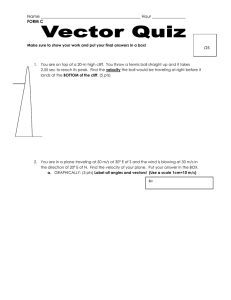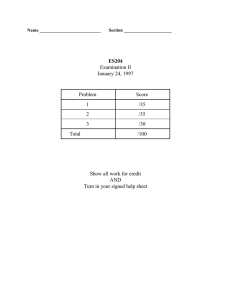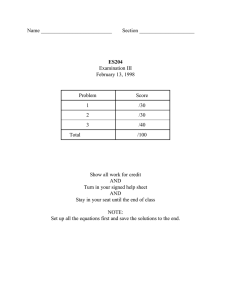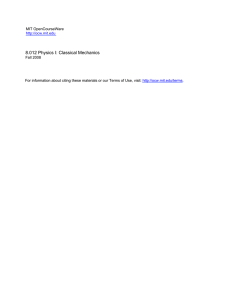8.012 Physics I: Classical Mechanics MIT OpenCourseWare rms of Use, visit: .
advertisement
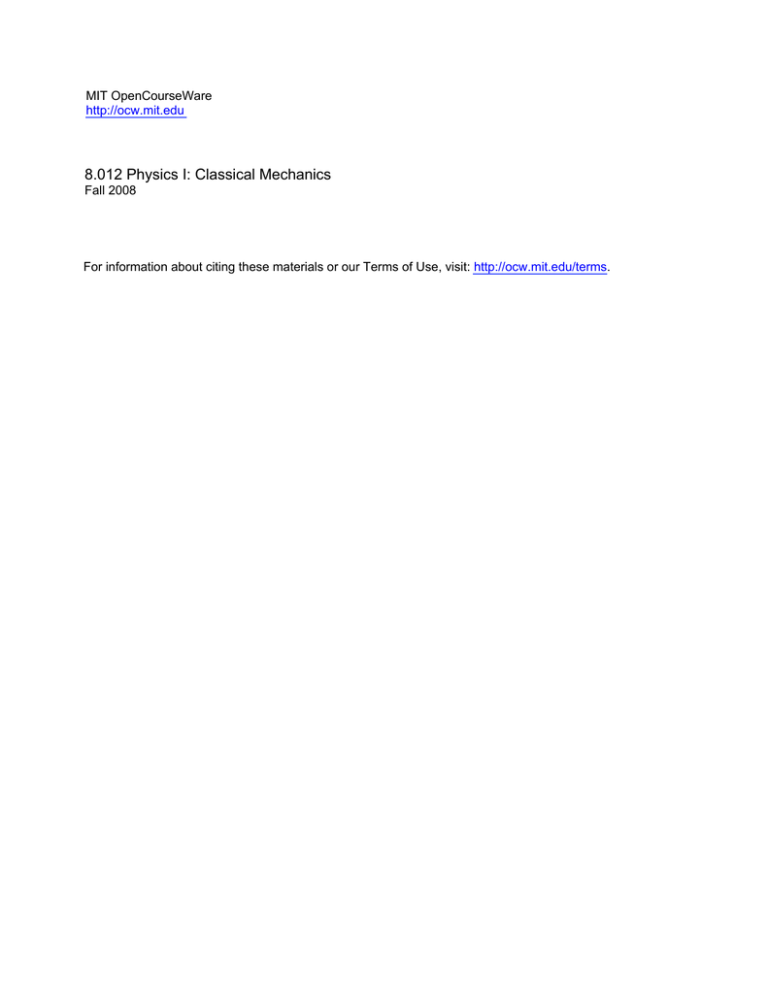
MIT OpenCourseWare http://ocw.mit.edu 8.012 Physics I: Classical Mechanics Fall 2008 For information about citing these materials or our Terms of Use, visit: http://ocw.mit.edu/terms. 8.012 Fall 2006 Quiz 2 Problem 1: Masses and Rod [15 pts] A block with mass 3M connected to a massless rod of length L lies at rest on a fixed frictionless table. A second block of mass M impinges on the system with speed v0, strikes the opposite end of the rod at a right angle, and sticks. For this problem, assume that the dimensions of the blocks are much smaller than the length of the rod. (a) [5 pts] What is the final velocity of the center of mass of the block-rod-block system? (b) [5 pts] What is the final angular velocity of the block-rod-block system about its center of mass? (d) [3 pts] What is the initial velocity of the more massive block after the collision? Be sure to indicate its direction and speed. Page 2 of 17 8.012 Fall 2006 Quiz 2 A uniform hoop with mass M, outer radius R and inner radius R/2 is initially spinning with angular velocity 0. The hoop is placed onto a uniform disk, also of mass M and outer radius R, that is initially at rest on a fixed frictionless table. The hoop and disk are aligned along their centers of mass. There is a coefficient of friction between the hoop and disk where their surfaces make contact. Gravitational acceleration is assumed to be constant and points downward. (a) [10 pts] What is the initial torque (about its center of mass) acting on the disk? What is the initial torque (about its center of mass) acting on the hoop? (b) [5 pts] The friction force between the hoop and disk cause them to eventually spin at the same angular velocity. What is this angular velocity? (c) [5 pts] How much time does it take for the disk and hoop to reach this common angular velocity? Page 11 of 17 8.012 Fall 2006 Final Exam Problem 7: Spinning Bouncing Ball [15 pts] A uniform sphere of mass M and radius R spinning with angular velocity ! is dropped from a height H. It bounces on the floor and recoils with the same vertical velocity. During the bounce, the surface of the ball slips relative to the surface of the floor (i.e., it does not roll) and in the process the ball is acted upon by a friction force with magnitude ƒ = µN, where N is the normal contact force between the ball and the floor and µ is a constant. Hence, the ball experiences impulses in both vertical and horizontal directions. Assume that the duration of contact, "t, is very short. (a) What angle # with respect to vertical does the ball recoil? (b) What is the final rotation velocity of the ball? (c) What value of H results in the ball bouncing off with no spin? Page 21 of 28 8.012 Fall 2006 Final Exam Problem 2: The Double Gyroscope [15 pts] A gyroscope consists of two identical uniform disks with mass M and radius R mounted on a rigid axle with length 2D. The axle is fixed to the outer disk, while the inner disk is allowed to spin freely but is constrained to remain at a distance D from the pivot (at left) by a collar. The axle spins about the pivot freely on a frictionless mount. The outer disk and axle are initially spun up to an angular frequency !0. Assume that the mass of the axle and pivot mount are negligible. Gravity points downward. Ignore nutation. (a) Calculate the precession rate ! of the gyroscope assuming that the inner disk is not spinning. Assume that !0 is very large and the gyroscopic approximation applies. (b) Friction between the axle and the disk closest to the pivot causes the latter to spin up. Assuming that a constant torque " acts at the interface between the axle and inner hole of this disk, calculate the final spin rate ! of both disks and the final precession rate in terms of the initial precession rate. (c) How much energy is lost from the gyroscope system during the spinning up of the inner disk? Page 6 of 28 8.012 Fall 2007 Quiz 2 Problem 2: The Bowling Ball [25 pts] A bowling ball of radius R, mass M and uniform mass density is thrown down a lane with initial horizontal speed v0. The ball is given some backspin – it is spun in the opposite direction of motion – with initial angular rate !0 as shown. The maximum coefficient of friction between the ball and lane surfaces is µ. Assume constant gravitational acceleration points downward. (a) [10 pts] Find the velocity and angular rotation rate ! of the ball as a function of time after it makes contact with the lane, and up to the point when it starts to roll without slipping. Note: directions are important here! (b) [10 pts] Find the “final” velocity and angular rotation rate of the ball when it starts to roll without slipping. (c) [5 pts] How must the initial conditions, v0 and !0, be related for the ball to come to rest? Page 5 of 21 8.012 Fall 2007 Quiz 2 Problem 4: A Ballistic Rotator [20 pts] A thin arrow with length R, mass m and uniform linear mass density ! = M/R is shot with velocity v into a circular target of radius R, mass M, uniform surface mass density " = M/!R2, and negligible thickness (i.e., it is essentially a thin disk). The arrow head sticks into the target just off center by a distance x < R as shown above. The target is mounted onto a central frictionless shaft, about which it can spin freely. The target is at rest before it is struck by the arrow. (a) [10 pts] Find the angular rotation rate of the target (with arrow embedded) after the arrow strikes it. You can express you answer in terms of IT, the moment of inertia of the circular target alone about the rotation axis shown. (b) [5 pts] Show that if m << M then to first order the rotation rate depends linearly on both x and v. (c) [5 pts] Derive an expression for IT in terms of M and R. Warning! This is a difficult problem, so save it for last! Page 13 of 21
